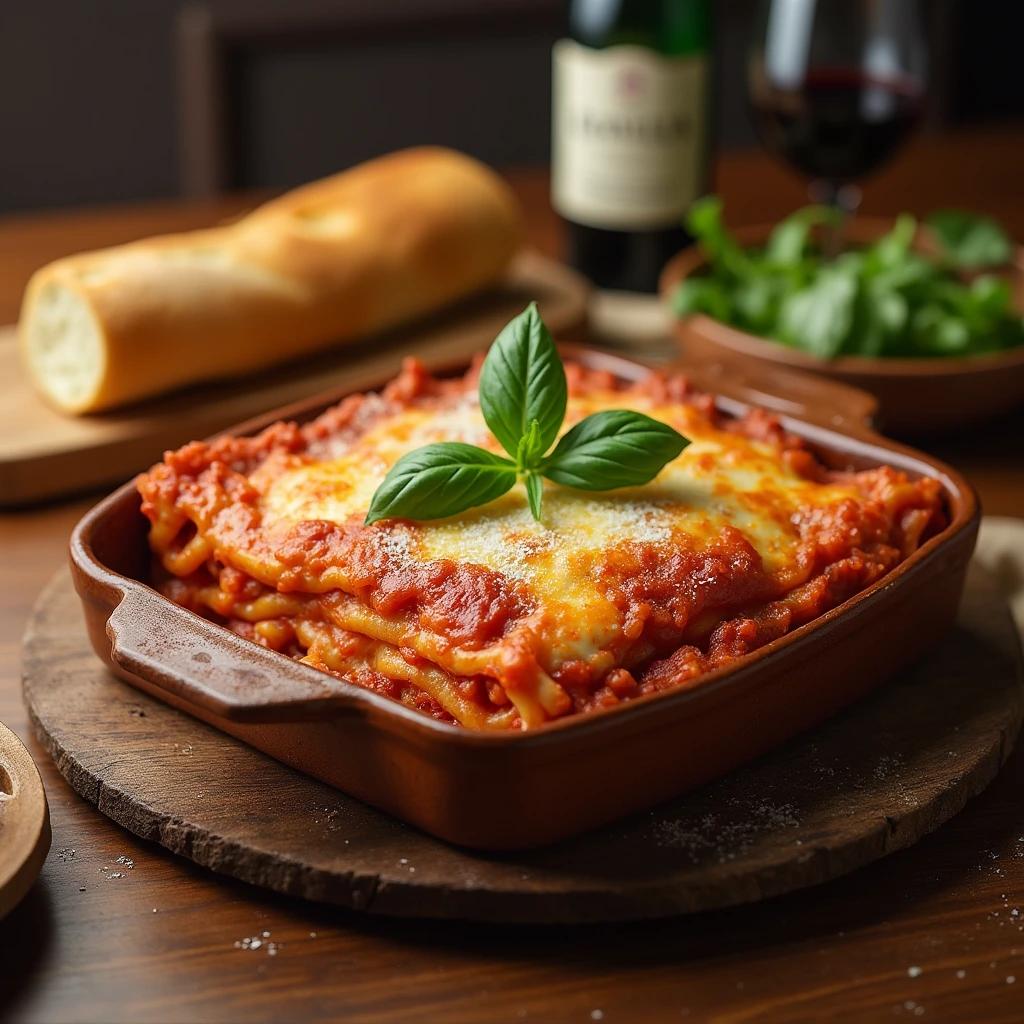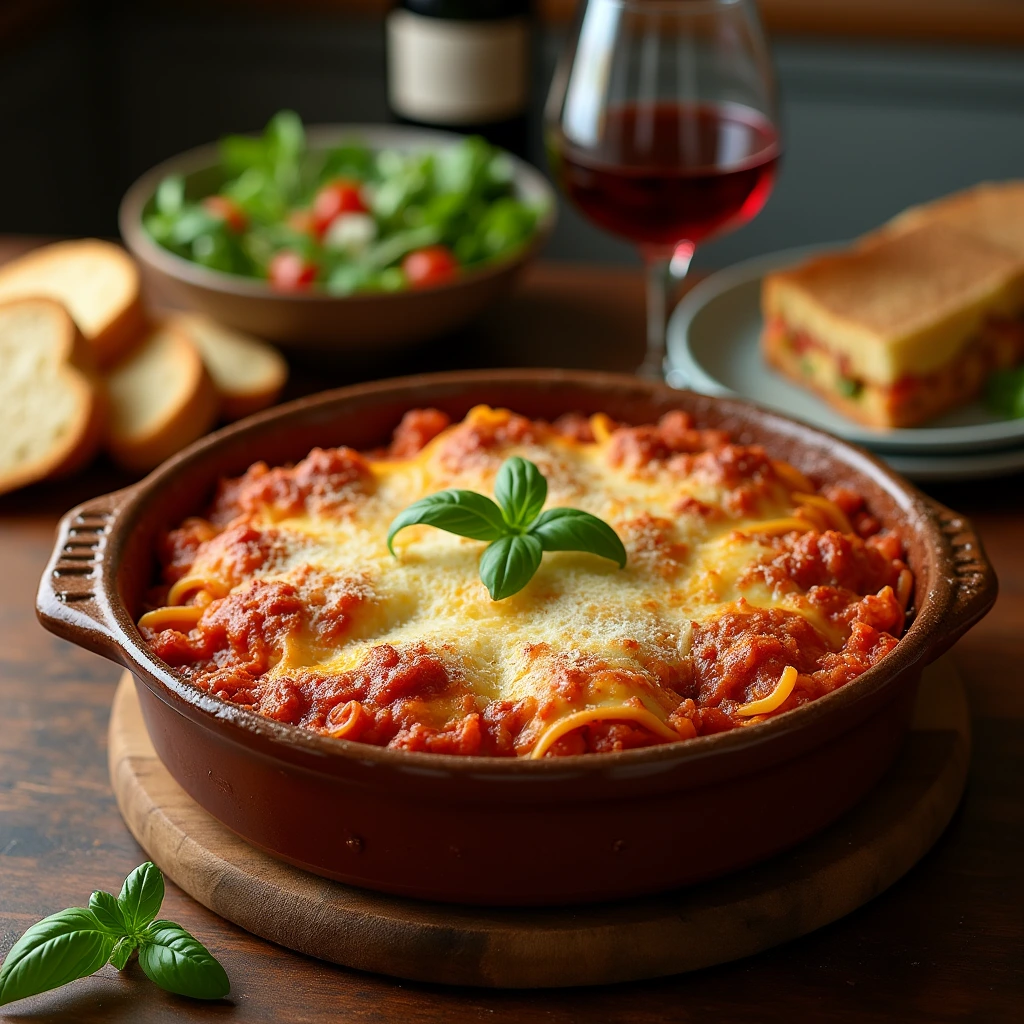About Barilla Lasagna Recipe
Barilla lasagna recipe remains a top choice among pasta lovers worldwide, especially for creating authentic Italian dishes. Renowned for its premium quality and rich heritage, Barilla combines versatility, flavor, and convenience to deliver a delightful cooking experience. Not only do its sheets hold sauces and layers perfectly, but they also ensure a consistently delicious result every time.

One reason for its popularity is its adaptability to various recipes, such as classic meat lasagna or vegetarian alternatives. Additionally, Barilla’s no-boil lasagna sheets simplify the process, saving valuable time without sacrificing taste or texture. Furthermore, these sheets, made from high-quality durum wheat semolina, provide a consistently firm and al dente texture, which enhances the overall dish.
Using Barilla lasagna offers several benefits. For example, its durable sheets resist breaking, ensuring smooth layering with sauces, creamy béchamel, and flavorful fillings. Moreover, with natural, non-GMO ingredients, Barilla caters to modern dietary needs while preserving its traditional Italian roots. This attention to quality makes it a trusted choice for households everywhere.
Ultimately, Barilla’s innovation and dedication to excellence transform meals into unforgettable culinary experiences. Whether preparing a simple family dinner or impressing guests, Barilla ensures every bite feels satisfying and wholesome. Its superior texture, ease of use, and reliable results make it a staple in kitchens worldwide.
Ingredients for Barilla Lasagna Recipe
Creating a delicious Barilla lasagna requires carefully chosen ingredients to ensure a flavorful and satisfying dish. Below are the essential components, optional additions, and substitutions to cater to various dietary preferences.
Main Ingredients
To prepare a classic Barilla lasagna, you will need the following key ingredients:
- Barilla lasagna sheets: These provide the perfect base for layering and hold up well during baking.
- Ground beef: Adds richness and depth of flavor to the dish.
- Ricotta cheese: A creamy layer that enhances texture and taste.
- Mozzarella: Melts beautifully, creating a gooey and satisfying bite.
- Parmesan: Adds a sharp, nutty flavor to complement the mozzarella and ricotta.
- Marinara sauce: Provides a tangy and savory element, tying all the layers together.
Optional Ingredients
For added nutrition and variety, you can include these optional ingredients:
- Spinach: Introduces a fresh, earthy flavor and boosts nutritional value.
- Mushrooms: Adds a meaty texture and umami richness.
- Vegetarian alternatives: Use plant-based ground “meat” or tofu for a meat-free option.
Ingredient Substitutions
Barilla lasagna is versatile, allowing for substitutions to suit dietary needs:
- Gluten-free lasagna sheets: For those with gluten sensitivities, these are an excellent replacement.
- Vegan cheese alternatives: Plant-based ricotta, mozzarella, and parmesan work well for a dairy-free lasagna.
- Low-fat options: Use low-fat cheeses or ground turkey instead of beef for a lighter dish.
With these ingredients, you can create a delicious Barilla lasagna tailored to your taste and dietary preferences.
How to Prepare Barilla Lasagna Recipe
Preparing Barilla lasagna involves three key steps: crafting a flavorful sauce, mixing a creamy cheese layer, and assembling the dish. By following these tips, you can ensure a perfect lasagna every time.
Preparing the Sauce
First, start by preparing a rich and flavorful sauce as the foundation of your lasagna:
- For marinara sauce, begin by sautéing minced garlic and onions in olive oil. Then, add crushed tomatoes, Italian seasoning, salt, and pepper. Allow it to simmer so the flavors can develop fully.
- For meat sauce, brown ground beef or sausage, drain the excess fat, and combine it with marinara sauce. Moreover, for added depth, consider including a splash of red wine or a pinch of sugar to balance acidity.
Let the sauce cook until thickened because this prevents the lasagna from becoming too watery.
Preparing the Cheese Mixture
Next, move on to the cheese mixture, which adds creamy texture and richness to the dish:
- Combine ricotta cheese, grated parmesan, and a beaten egg in a bowl.
- Stir the mixture until smooth, and then season it lightly with salt, pepper, and a pinch of nutmeg for added flavor.
- Additionally, you can fold in shredded mozzarella or chopped fresh herbs like parsley to enhance the taste.
This step ensures the layers will bind together and remain flavorful.
Assembling the Lasagna
Finally, assemble the lasagna to create balanced layers of textures and flavors:
- Start by spreading a thin layer of sauce on the bottom of the baking dish to prevent sticking.
- Then, add a layer of Barilla lasagna sheets, ensuring they don’t overlap.
- After that, spread a layer of sauce, followed by the cheese mixture, and, if desired, optional vegetables like spinach or mushrooms.
- Repeat these layers, ending with a generous topping of shredded mozzarella and parmesan.
Bake at 375°F (190°C) for 45 minutes, covering with foil. Lastly, uncover for the final 10 minutes to achieve a golden, bubbly top. Let it rest briefly before serving to ensure clean slices.
Baking Tips for the Perfect Lasagna
Achieving a perfect lasagna involves careful attention to oven temperature, cooking time, and avoiding common pitfalls. Follow these tips to ensure a delicious and evenly baked dish.
Ideal Oven Temperature
Preheating your oven is essential for even cooking. Set the oven to 375°F (190°C), which is the ideal temperature for baking lasagna. Preheating ensures consistent heat distribution throughout the dish. If your lasagna includes a thick layer of sauce or raw vegetables, this temperature allows the layers to cook thoroughly without drying out.
Cooking Time
Cooking lasagna to perfection requires patience and proper timing:
- Cover the dish with aluminum foil during the first 45 minutes of baking. This step traps steam, helping the pasta sheets cook evenly and preventing the top from drying out.
- Remove the foil for the final 10-15 minutes to allow the cheese to melt and turn golden brown. This step ensures a bubbly, appetizing crust.
- Always let the lasagna rest for 10-15 minutes after removing it from the oven. Resting allows the layers to set, making it easier to cut clean slices.
Avoiding Common Mistakes
To avoid dry lasagna, soggy layers, or uneven cooking, keep these tips in mind:
- Don’t skimp on sauce. Each layer of pasta should be generously coated to prevent dryness.
- Avoid watery sauces or vegetables. Drain ingredients like spinach or mushrooms before adding them to the lasagna.
- Ensure even layering. Spread the sauce and cheese mixture consistently for uniform cooking.
- Finally, use a sturdy baking dish that retains heat well for consistent results.
By following these tips, you’ll bake a perfectly balanced lasagna with rich flavors, tender pasta, and a golden, cheesy crust.
Serving and Presentation of Barilla Lasagna Recipe
The way you serve and present your lasagna can enhance the overall dining experience. From garnishing to side dishes and tips for handling leftovers, here’s how to make your lasagna shine.
Garnishing Ideas
A beautifully garnished lasagna elevates its appeal. Consider these simple yet effective garnishing ideas:
- Sprinkle fresh basil leaves or chopped parsley on top for a vibrant touch of color and freshness.
- Add a light drizzle of olive oil to enhance flavor and give the dish a glossy finish.
- If desired, sprinkle extra grated parmesan or red pepper flakes for a bold flavor boost.
Ideal Side Dishes
Pairing lasagna with the right side dishes balances the meal and complements its rich flavors. Here are a few ideal choices:
- A crisp Caesar salad or mixed greens with a tangy vinaigrette helps cut through the lasagna’s richness.
- Serve with warm garlic bread or breadsticks to soak up the extra sauce.
- Add a serving of roasted vegetables, such as zucchini, bell peppers, or asparagus, to bring a light and healthy contrast.
These side dishes complete the meal without overpowering the main course.
Storing and Reheating Tips
To enjoy leftovers, follow these best practices for storing and reheating:
- Let the lasagna cool completely before refrigerating in an airtight container. Properly stored, it lasts 3-5 days in the refrigerator.
- For longer storage, freeze individual portions tightly wrapped in foil or freezer-safe containers for up to 3 months.
- Reheat leftovers in the oven at 350°F (175°C), covered with foil to retain moisture. Alternatively, microwave on medium heat in short intervals, checking frequently.
With these tips, your lasagna will remain delicious whether served fresh or as leftovers.
FAQs
Do you need to boil Barilla lasagna?
No, Barilla offers no-boil lasagna sheets that don’t require pre-cooking. These sheets are designed to soften perfectly during baking by absorbing moisture from the sauce and other ingredients. This saves time and simplifies the preparation process while still delivering a delicious, al dente texture.
What are the correct layers for lasagna?
The traditional layers for lasagna follow a simple structure:
- Start with a thin layer of sauce at the bottom of the dish.
- Add a layer of lasagna sheets, ensuring they don’t overlap.
- Spread a layer of sauce, followed by a layer of cheese mixture (such as ricotta, parmesan, and mozzarella).
- Repeat the layers until you reach the top, finishing with a layer of sauce and shredded cheese for a golden crust.
Consistency in layering ensures even cooking and balanced flavors.
Do no-boil lasagna noodles really work?
Yes, no-boil lasagna noodles work effectively when used with recipes that include enough moisture from sauce or fillings. The liquid from these components softens the noodles as they bake, resulting in a texture comparable to boiled noodles. Just make sure the sauce is not too dry to prevent the noodles from remaining hard.
Should homemade lasagna be covered or uncovered?
Homemade lasagna should be covered with aluminum foil for the majority of the baking time. Covering traps steam, allowing the layers to cook evenly and preventing the top from drying out. During the final 10-15 minutes of baking, uncover the dish to let the cheese melt and turn golden brown for a bubbly, appetizing crust.
Additional Ressources
When exploring lasagna recipes and techniques, you may find additional resources and inspiration helpful for refining your skills and experimenting with flavors. For instance, the Barilla Official Website offers a variety of recipes tailored to their pasta products, including classic and innovative lasagna dishes. Their website also provides tips on pairing sauces and selecting ingredients for the perfect Italian meal. If you’re interested in learning more about layering techniques or lasagna variations, AllRecipes and Delish feature user-friendly guides and step-by-step instructions for creating lasagna suited to various preferences, including vegetarian and gluten-free options. Additionally, for in-depth culinary insights and authentic Italian recipes, La Cucina Italiana is an excellent resource, showcasing traditional lasagna recipes and modern twists on the classic dish.
For those with dietary restrictions, websites like Minimalist Baker and Gluten-Free Living offer creative ways to adapt lasagna recipes for vegan, low-fat, or gluten-free lifestyles. Lastly, if you’re curious about wine pairings to complement your lasagna, Wine Folly provides detailed guides on choosing the best wines to enhance the flavors of your dish. These external links can help elevate your cooking experience and broaden your culinary repertoire.
You can discover more recipes on our website:
Conclusion
Barilla lasagna is a timeless recipe that brings together simplicity and exceptional flavor, making it a favorite for family meals and special occasions alike. With high-quality Barilla lasagna sheets, a rich sauce, creamy cheese layers, and customizable ingredients, you can create a dish that satisfies any palate.
The process is straightforward: craft a flavorful sauce, mix a creamy ricotta-based filling, and layer the ingredients carefully for a balanced and delicious outcome. Thanks to Barilla’s no-boil lasagna sheets, the preparation is even easier, saving time without compromising on taste or texture. By following the baking tips and layering techniques, you’ll achieve a perfectly cooked lasagna with tender pasta, a rich filling, and a golden, bubbly top.
This dish is as versatile as it is satisfying. Whether you stick to the classic recipe or experiment with optional ingredients like spinach or mushrooms, Barilla lasagna offers endless possibilities to adapt to your preferences. Pair it with fresh garnishes, a crisp salad, or warm garlic bread for a complete and memorable meal.
In addition, leftover lasagna stores and reheats beautifully, making it a practical choice for meal prep or busy weeknights. Its layers of flavor only deepen over time, ensuring every serving is as delightful as the first.
With its simple preparation and consistently delicious results, Barilla lasagna is more than just a meal—it’s a centerpiece for sharing joy and creating lasting memories around the table.

